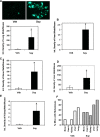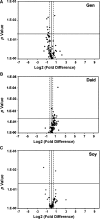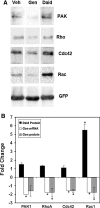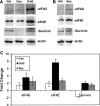Individual and combined soy isoflavones exert differential effects on metastatic cancer progression
- PMID: 20517637
- PMCID: PMC2944964
- DOI: 10.1007/s10585-010-9336-x
Individual and combined soy isoflavones exert differential effects on metastatic cancer progression
Abstract
To investigate the effects soy isoflavones in established cancers, the role of genistein, daidzein, and combined soy isoflavones was studied on progression of subcutaneous tumors in nude mice created from green fluorescent protein (GFP) tagged-MDA-MB-435 cells. Following tumor establishment, mice were gavaged with vehicle or genistein or daidzein at 10 mg/kg body weight (BW) or a combination of genistein (10 mg/kg BW), daidzein (9 mg/kg BW), and glycitein (1 mg/kg BW) three times per week. Tumor progression was quantified by whole body fluorescence image analysis followed by microscopic image analysis of excised organs for metastases. Results show that daidzein increased while genistein decreased mammary tumor growth by 38 and 33% respectively, compared to vehicle. Daidzein increased lung and heart metastases while genistein decreased bone and liver metastases. Combined soy isoflavones did not affect primary tumor growth but increased metastasis to all organs tested, which include lung, liver, heart, kidney, and bones. Phosphoinositide-3-kinase (PI3-K) pathway real time PCR array analysis and western blotting of excised tumors demonstrate that genistein significantly downregulated 10/84 genes, including the Rho GTPases RHOA, RAC1, and CDC42 and their effector PAK1. Daidzein significantly upregulated 9/84 genes that regulate proliferation and protein synthesis including EIF4G1, eIF4E, and survivin protein levels. Combined soy treatment significantly increased gene and protein levels of EIF4E and decreased TIRAP gene expression. Differential regulation of Rho GTPases, initiation factors, and survivin may account for the disparate responses of breast cancers to genistein and daidzein diets. This study indicates that consumption of soy foods may increase metastasis.
Figures






Similar articles
-
Soy isoflavones enhance radiotherapy in a metastatic prostate cancer model.Int J Cancer. 2007 Jun 1;120(11):2491-8. doi: 10.1002/ijc.22548. Int J Cancer. 2007. PMID: 17304503
-
Soy-derived isoflavones inhibit the growth of adult T-cell leukemia cells in vitro and in vivo.Cancer Sci. 2007 Nov;98(11):1740-6. doi: 10.1111/j.1349-7006.2007.00595.x. Epub 2007 Aug 28. Cancer Sci. 2007. PMID: 17727682 Free PMC article.
-
The soy isoflavone equol may increase cancer malignancy via up-regulation of eukaryotic protein synthesis initiation factor eIF4G.J Biol Chem. 2012 Dec 7;287(50):41640-50. doi: 10.1074/jbc.M112.393470. Epub 2012 Oct 24. J Biol Chem. 2012. PMID: 23095751 Free PMC article.
-
The Use of Soy Isoflavones in the Treatment of Prostate Cancer: A Focus on the Cellular Effects.Nutrients. 2023 Nov 21;15(23):4856. doi: 10.3390/nu15234856. Nutrients. 2023. PMID: 38068715 Free PMC article. Review.
-
Soy isoflavones and prostate cancer: a review of molecular mechanisms.J Steroid Biochem Mol Biol. 2014 Mar;140:116-32. doi: 10.1016/j.jsbmb.2013.12.010. Epub 2013 Dec 25. J Steroid Biochem Mol Biol. 2014. PMID: 24373791 Free PMC article. Review.
Cited by
-
Targeting Breast Cancer Stem Cells Using Naturally Occurring Phytoestrogens.Int J Mol Sci. 2022 Jun 18;23(12):6813. doi: 10.3390/ijms23126813. Int J Mol Sci. 2022. PMID: 35743256 Free PMC article. Review.
-
Enhancing the effectiveness of androgen deprivation in prostate cancer by inducing Filamin A nuclear localization.Endocr Relat Cancer. 2012 Nov 9;19(6):759-77. doi: 10.1530/ERC-12-0171. Print 2012 Dec. Endocr Relat Cancer. 2012. PMID: 22993077 Free PMC article.
-
Synergistic Action of Genistein and Calcitriol in Immature Osteosarcoma MG-63 Cells by SGPL1 Up-Regulation.PLoS One. 2017 Jan 26;12(1):e0169742. doi: 10.1371/journal.pone.0169742. eCollection 2017. PLoS One. 2017. PMID: 28125641 Free PMC article.
-
High levels of dietary soy decrease mammary tumor latency and increase incidence in MTB-IGFIR transgenic mice.BMC Cancer. 2015 Feb 6;15:37. doi: 10.1186/s12885-015-1037-z. BMC Cancer. 2015. PMID: 25655427 Free PMC article.
-
Soy and Frequent Dairy Consumption with Subsequent Equol Production Reveals Decreased Gut Health in a Cohort of Healthy Puerto Rican Women.Int J Environ Res Public Health. 2021 Aug 4;18(16):8254. doi: 10.3390/ijerph18168254. Int J Environ Res Public Health. 2021. PMID: 34444002 Free PMC article.
References
-
- Murkies AL, Teede HJ, Davis SR. What is the role of phytoestrogens in treating menopausal symptoms? Med J Aust. 2000;173(Suppl):S97–S98. - PubMed
-
- Lampe JW, Nishino Y, Ray RM, Wu C, Li W, Lin MG, Gao DL, Hu Y, Shannon J, Stalsberg H, Porter PL, Frankenfeld CL, Wahala K, Thomas DB. Plasma isoflavones and fibrocystic breast conditions and breast cancer among women in Shanghai, China. Cancer Epidemiol Biomarkers Prev. 2007;16:2579–2586. doi: 10.1158/1055-9965.EPI-07-0368. - DOI - PubMed
Publication types
MeSH terms
Substances
Grants and funding
LinkOut - more resources
Full Text Sources
Other Literature Sources
Research Materials
Miscellaneous

